Amazon Retargeting – Next Level Advertising
If you look at the full range of options available with Programmatic Advertising at Amazon DSP, retargeting is probably the most cost-effective form of advertising that significantly drive sales of Amazon products. Retargeting ads on and outside of Amazon are, similar to sponsored product ads, located closest to the purchase transaction within the customer journey, and therefore generate sales-relevant traffic. There is hardly a scenario where it is not worthwhile (or not possible) to run retargeting campaigns as a seller or vendor Amazon.
In this article, we want to explain all the details of Amazon Retargeting, how it works, how to combine it with PPC campaigns and the costs and benefits. To anticipate one thing right away: Retargeting campaigns for your own Amazon products is almost always worthwhile. On the one hand, this type of advertising is very sales-driven, i.e. a regular ROI (Return of Investment), or ROAS (Return of Advertising Spend) is almost always “guaranteed”. On the other hand, retargeting directs valuable and well-converting traffic to your products, which in turn affects the organic ranking as well as the performance of the PPC campaigns.
- What is retargeting?
- Remarketing or Retargeting?
- Retargeting in the Amazon DSP
- How do you combine DSP and PPC?
- How does Amazon Retargeting work?
- What are Dynamic eCommerce Ads?
- What are the advantages of Amazon Retargeting?
- Amazon (ASIN) Retargeting Example
- What do Amazon Retargeting campaigns cost?
Definition: Retargeting
Retargeting is by no means a new invention of Amazon because this form of advertising and the way it is played out has been around for quite some time. Retargeting has been used most frequently by advertisers for years via Google Ads (formerly Google Adwords) and Facebook Ads. But what is retargeting actually, and how does it work?
In general, retargeting (in some cases also called remarketing) is a component of programmatic advertising. Amazon has its own DSP (Demand Side Platform) for the management of programmatic campaigns, which was partly bought out of the bankruptcy estate of the ad tech provider “Sizmek” and integrated into the Amazon Advertising Console.
The term “retargeting” is made up of two parts. It is thus almost self-explanatory: “Re” stands for “retargeting” and “targeting” in the broadest sense of the word means “retargeting” – i.e. “addressing the target group again”. The way retargeting works is explained just as simply
Retargeting Example
A user visits a website and looks at a product. At this moment “a cookie” is set, which stores the time of the visit and the essential website + product information. The user decides not to buy the product and leaves the website. He continues surfing on another website. This has a reserved advertising space, which is connected to a so-called SSP (Supply Side Platform), through which advertising can be played automatically (programmatically). A small script reads the user’s cookie. It automatically displays the product just visited in the form of a personal advertisement. This all happens within a few milliseconds and fully automatically. Since the user is familiarised with the product (he just looked at it a few minutes, hours or days ago), his focus is quickly shifted to the advertisement, as it matches his web search and buying behavior. Thus, the click and purchase probability is very high when retargeting compared to so-called awareness campaigns.
Remarketing vs Retargeting – Are they Different?
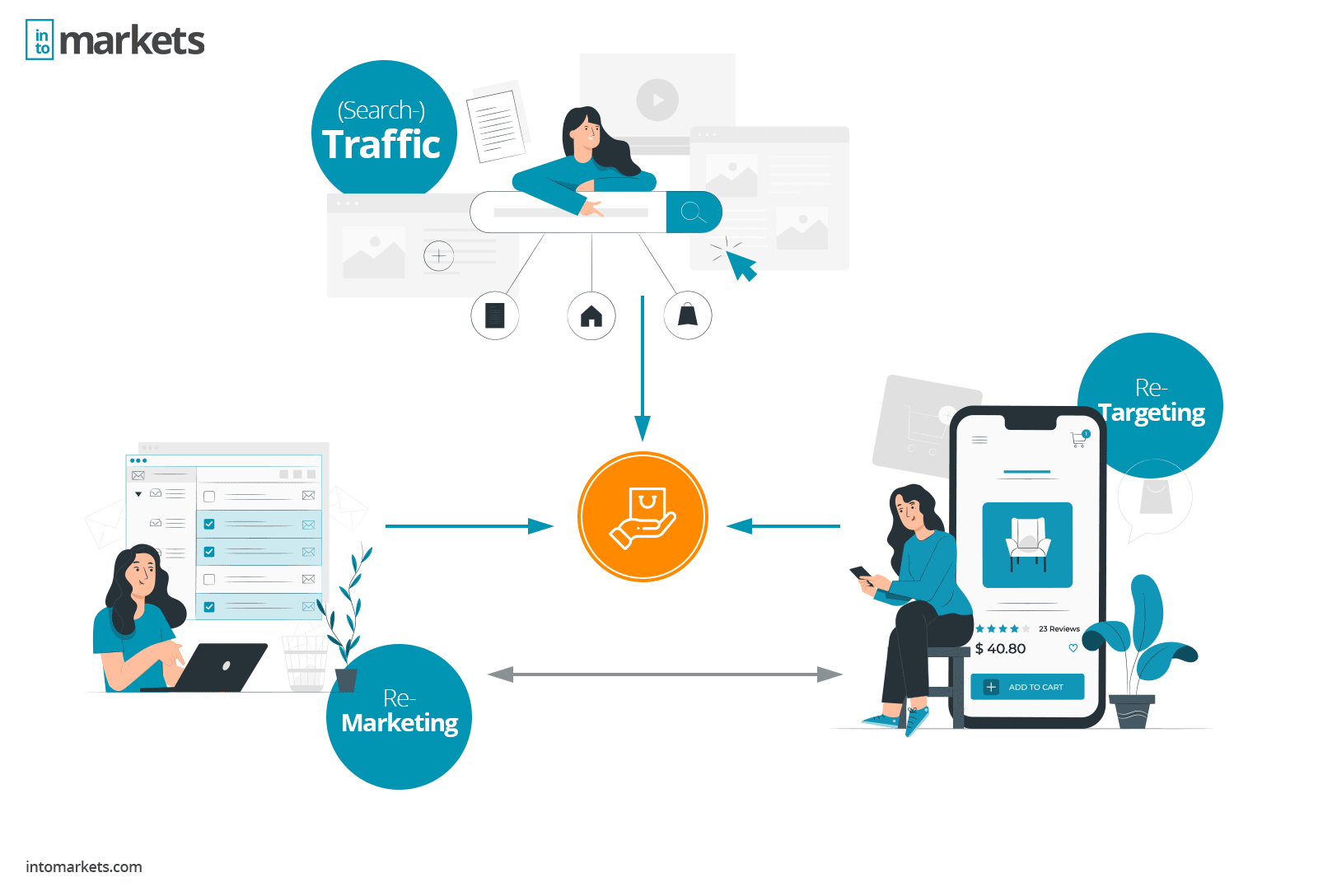
In online marketing and especially in e-commerce, the two terms remarketing, and retargeting are often used together in the same context. But what are the differences? In essence, it is quite simply explained, because actually both mean the same thing: The retargeting of users who have looked at their own (digital) offers. However, there are subtle differences between remarketing and retargeting.
Retargeting is used mainly in e-commerce and consequently also in relation to the Amazon DSP. In concrete, users who are ready to buy are retargeted here, for example those who have looked at a product on Amazon but not bought it. The aim of retargeting is to lead the user back to the offer on the marketplace (or webshop outside of Amazon) and to persuade him to complete the purchase. In the Amazon DSP environment, retargeting campaigns are played out via so-called “dynamic e-commerce ads”, which show the product and its key data such as reviews, prime logo, title, and purchase price. Retargeting works very similarly via Google, except that here the ad itself has to be designed.
Remarketing works similarly, but there is a difference in the actual purpose of use. Re-marketing is usually only used for e-mail campaigns but has the same goal: to lead users back to an offer. The crucial difference here is the specific way in which users are addressed. In remarketing, users are addressed by follow-up e-mails. For example, if a user places a product in the Amazon shopping cart but does not buy it, Amazon automatically sends remarketing e-mails to the corresponding users to remind them of their “forgotten” product in the shopping cart and ultimately entice them to buy it
Retargeting is a part of Amazon DSP
Sellers and vendors who have been offering and promoting their products on the marketplace for a long time are to date mainly using the Amazon Advertising Console (or with Sponsored Ads in SellerCentral), where click- and keyword-based performance marketing campaigns are run. Programmatic campaigns, which include retargeting, have in turn been exclusively part of the Amazon DSP until the end of 2019, i.e. Amazon’s own demand-side platform. Relatively new in this context are the Sponsored Display Ads, which can be placed in the Amazon BrandRegistry via the well-known Advertising Console if the brand is registered in the Amazon BrandRegistry, but technically correct belongs to the discipline of programmatic advertising. The Sponsored Display Ads are by no means an alternative nor even have the same functions as the Retargeting Ads in the Amazon DSP. They are rather, a supplementary form of advertising, with which programmatic campaigns can be placed based on search and purchase behavior – but within the classic Advertising Console this is only possible in a very limited way.
It is therefore important to understand that all dedicated retargeting campaigns can only run via the Amazon DSP in managed service (directly via employees of the AMG, Amazon Media Group) or self-service (via an Amazon agency or own entities).
Amazon Retargeting is only a small part of the complete functional range of the demand-side platform. The real strength of this programmatic advertising platform lies in the totality and diversity of the target group approach across all user touchpoints. Like paid search campaigns, retargeting starts relatively deep, or rather late, in the conversion funnel. Only when a user has already viewed an Amazon product can he or she be “followed up” by means of retargeting advertising within and outside the marketplace. Regarding a possible ROI (Return on Investment) or ROAS (Return of Advertising Spend), retargeting campaigns are of course very effective, because one directly addresses the individual web search and buying behavior of the users. However, in order to direct potential buyers to the corresponding product, extensive advertising measures may be necessary, which can be carried out in combination with e.g. sponsored brands and sponsored product ads and subsequent retargeting.
Combine Amazon DSP and Amazon PPC sensibly (switch simultaneously)
If one begins a step earlier, in which a user is to be brought to the product or sensitized for the purchase, then one will reach this target group neither with Paid Search nor with Retargeting-Ads. This is where awareness campaigns come into play, as they can also be switched and controlled via the Amazon DSP. Once the user is “activated” for the product, i.e. his interest in buying is aroused, the next step is often the targeted product search on Amazon. This is where Amazon PPC, i.e. keyword-based advertising, shows its strengths. Provided that the product is professionally optimized for the A9 search algorithm and a possible conversion by the user (keyword “retail readiness”), good conditions are created for a high organic and inorganic reach. If the corresponding product is now reached, for example through targeted sponsored product ads, a purchase is anything but guaranteed despite an above-average high conversion rate on Amazon. The Amazon marketplace offers buyers in Germany alone around 300 million active products. The jump to another product on a product detail page is not unlikely on Amazon and the way back to your own article and thus also to the purchase conclusion is anything but safe. This is where Amazon Retargeting comes in because this is exactly where a “lost” buyer can always be brought back to the final purchase completion ( your product).
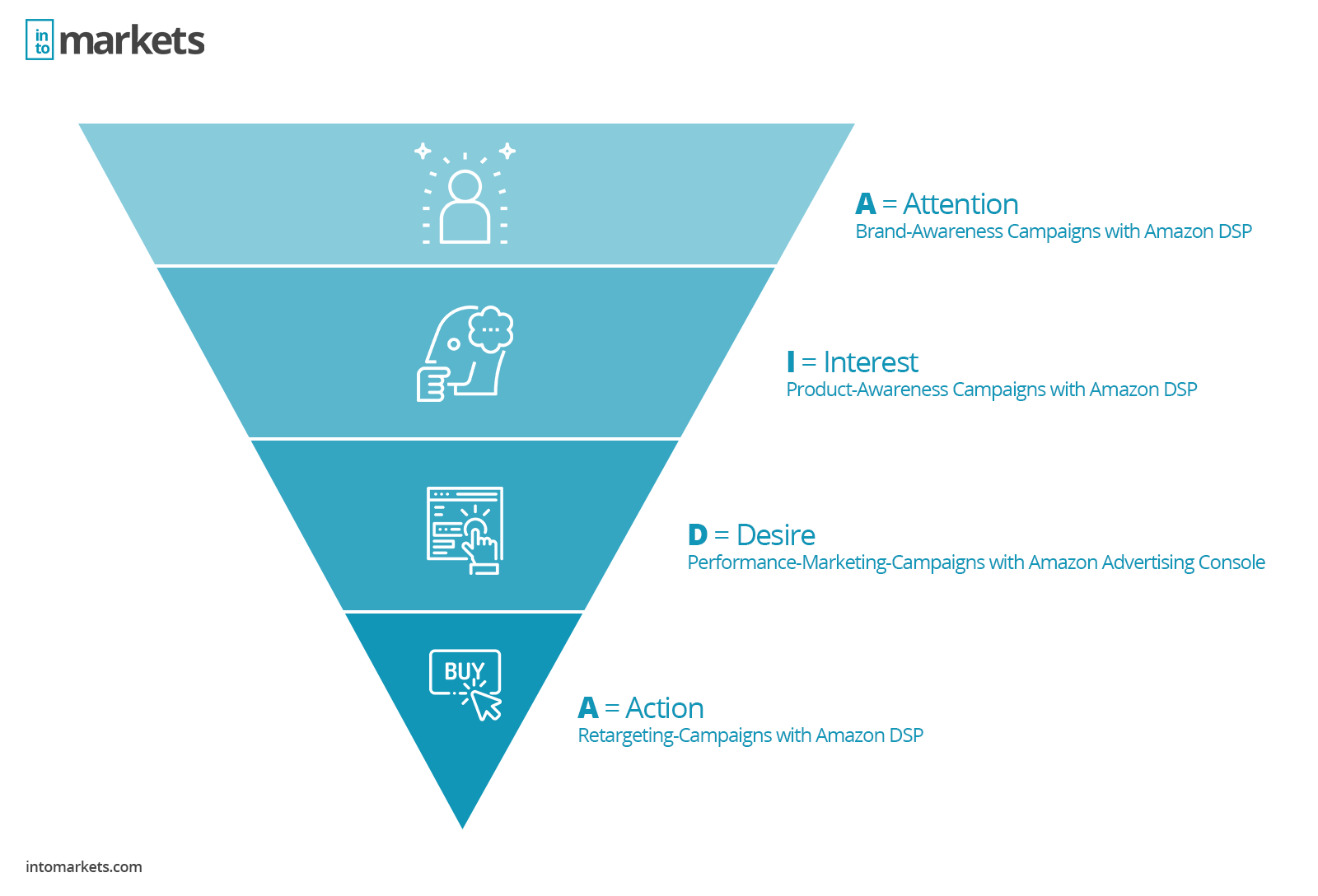
The interaction of awareness campaigns, paid search, and retargeting on Amazon can also be compared with the classic AIDA model:
A = Attention = Brand awareness campaigns with Amazon DSP (top level in the conversion funnel
I = Interest = Product awareness campaigns with Amazon DSP (one step down and one step further in the customer journey)
D = Desire = Performance marketing campaigns using Amazon PPC (high interest to buy exists, but has not yet been finally
decided)
A = Action = Retargeting campaigns with Amazon DSP (user is redirected to the products and the purchase is completed)
The exciting thing about Amazon Retargeting is that you cannot necessarily rely on the traffic of your own product in the final purchase decision phase. It is possible to advertise via users who are also willing to buy and who have looked at competing products or generally offers from a certain niche. Properly set up and combined with other forms of advertising, Amazon offers an incredibly wide, but also a deep range of advertising forms within its own ecosystem, which ultimately all lead to the same goal: Buy!
Download-Tip
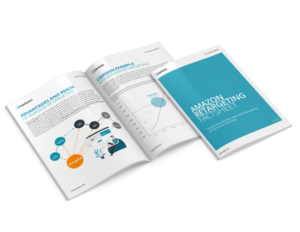 In this factsheet you get all the important facts you need to know about Amazon Retargeting: How to combine retargeting with PPC campaigns? How do you calculate a marginal return on your campaigns? What effects do retargeting campaigns have on other factors of the Amazon marketplace? Learn how to use these programmatic campaigns in such a way that they can increase your sales profitably and sustainably.
In this factsheet you get all the important facts you need to know about Amazon Retargeting: How to combine retargeting with PPC campaigns? How do you calculate a marginal return on your campaigns? What effects do retargeting campaigns have on other factors of the Amazon marketplace? Learn how to use these programmatic campaigns in such a way that they can increase your sales profitably and sustainably.
How Does Amazon Retargeting Work in Detail?
In general, the following principle applies to retargeting (as with any programmatic campaign): a significant amount of data is needed to display the advertisements. In the case of retargeting, this means that before the start of such a campaign, enough users who are willing to buy must have looked at the product before it can be sent back there. It does not matter whether a user came to the product detail page via external traffic (e.g. via a Facebook campaign), an organic search result, or via paid advertising (e.g. a Sponsored Brands Ad or Sponsored Product Ad). The only important thing is that the user has seen the product detail page. At this moment “a cookie” is set, storing whether this product was purchased. If this is not the case, retargeting campaigns can be used to track exactly this user even if he or she has left the Amazon website and continues surfing elsewhere.
In order to address a user in a targeted manner and to play out suitable advertising for this, the Amazon DSP offers seven different targeting options:
ASIN Retargeting – Product Searches
 If a user has entered a certain keyword that is related to the advertised ASIN, targeting can be set up. The keywords themselves cannot be defined or selected manually – Amazon determines these algorithmically and does not (currently) provide any more precise information about them.
If a user has entered a certain keyword that is related to the advertised ASIN, targeting can be set up. The keywords themselves cannot be defined or selected manually – Amazon determines these algorithmically and does not (currently) provide any more precise information about them.
ASIN Retargeting – Brand Views

If a user has looked at products of a brand within a certain period of time, then it can be specifically advertised. Brand view targeting is particularly useful if a brand has many complementary and well-matched items (e.g. shampoo + conditioner or grill gloves + grill tongs).
ASIN Retargeting – Brand Purchases

Analogous to the Brand Views, a user can be advertised if he has bought a product of a certain brand and you want to present him other products of the same brands. This targeting option is particularly useful if you want to persuade buyers to cross-sell and up-sell.
ASIN Retargeting – Product Views

This is probably the most common option for Amazon retargeting. If a user has seen a product but has not bought it, he will be targeted and continued to advertise until he finally buys the product or falls off the advertising grid.
ASIN Retargeting – Product Purchases
 Once a user has ordered an ASIN, it can be further promoted in a targeted manner utilizing retargeting. This always makes sense if, for example, a consumer product such as diapers, food supplements, detergents, perfume, etc. is involved.
Once a user has ordered an ASIN, it can be further promoted in a targeted manner utilizing retargeting. This always makes sense if, for example, a consumer product such as diapers, food supplements, detergents, perfume, etc. is involved.
ASIN Retargeting – SIM (Similarities) Product Views

If a user looks at comparable or very similar products of other brands, targeting can be set up for this. Exactly which ASINs are selected for this purpose is decided covertly by the Amazon algorithm, i.e. you can only select the option, but not view product lists.
ASIN Retargeting – Competitor Conquesting

Similar to SIM Product Views, this targeting option provides the ability to display advertisements to users who are interested in competing products. However, the difference here is that the ASINs can be specifically selected.
When choosing to target within the retargeting campaign, advertisers should always start from the product and the associated target group. With shampoo, for example, the targeting option “Product Purchases” can work very well with a certain time delay, because when the shampoo is used up or slowly running out, targeted advertising for exactly this product can be the key to success. If, on the other hand, the user buys a new smartphone, it should rather be excluded from the retargeting campaign. Although it would be a good idea to advertise suitable accessories such as headphones, charging stations or mobile phone covers, this is currently difficult to achieve with the current retargeting options of Amazon DSP and can lead to high wastage.
So it depends on the product, the target group and the buying behavior, which targeting you use for your campaigns.
Amazon Retargeting with Dynamic eCommerce Ads (DEAs)
If you want to run a programmatic advertising campaign, you will also need a so-called “visual” or “creative”, i.e. the designed advertisement that the target group should see later. In the past, such advertisements had to be designed completely by the users themselves, and whether or not they would appeal to the users and actually click on them was always a matter of luck or other times was just based on the “trial and error” principle. Amazon offers an alternative way of retargeting: The “Dynamic eCommerce Ads” or “DEA” for short. These are automatically generated advertisements based on the product data of the respective ASIN to be advertised. In most cases, a DEA contains the following elements:
- Product title
- Product image
- Reviews
- Price
- Prime Logo
- Call-to-Action button
All these elements are automatically put together and put into the right ad format.
Advantages of Amazon Retargeting with Dynamic eCommerce Ads
- The eight different standard formats of Dynamic eCommerce Ads are automatically generated, and the elements are brought into the appropriate size and orientation. This saves the advertiser a lot of time in the creation of the creatives. He or she can directly concentrate on targeting and budgeting.
- Programmatic Advertising, which includes Amazon Retargeting, is an enormously data-driven advertising approach. Even the best (human) designer cannot accurately assess every persona of every ad. Amazon closes this gap by providing a complex database of the surfing and clicking behavior of millions of users. This is exactly what the DEAs are based on. They are designed for optimal conversion.

Just imagine how much time and thus costs would go into creating retargeting ads if you had to design 100 products with 2 different campaigns each and a total of 8 standard ad formats. With this small product portfolio alone, you quickly come up with 1,600 different ads. Let us assume that the graphic designer knows his trade and works very effectively. He would need a processing time of only 3 minutes for each advertisement, this equals a total of 80 hours, i.e. at least 10 working days. And then you still don’t know whether these ads will convert well. If you now want to change the design of the ads, all designs have to be created manually again and the same amount of work and time would be required.
Time must also be invested in the creation of Dynamic eCommerce Ads, but it would be only a fraction of the manual work, being a great advantage for advertisers. Amazon has a few basic requirements for the ads used in retargeting campaigns:
- The ASIN must be known and available on Amazon.
- There must be at least 15 product reviews with an average rating of 3.5 stars or higher.
- A product image must be available or uploaded.
- The product should be in stock and therefore available/listed.
Targeting should be based on click-through rate, purchase rate or detailed page view rate, and if all of these are given, DEAs can be used for Amazon retargeting campaigns. You can also upload your own ad designs, but you should be very sure of yourself and create your designs strictly according to Amazon’s specifications. It is recommended to run at least one A/B test in parallel with the automatically generated ads within a campaign to compare impressions and CTR (click-through rate).
What Are the Advantages of Amazon Retargeting?
The incredibly wide range of products with hundreds of millions of active offers on Amazon is a great advantage from the consumer’s point of view, but for sellers and vendors it is an enormous challenge and sometimes even a disadvantage. A potential buyer is often quickly distracted by the product variety and leaves the product detail page without making a purchase. For some products with a higher purchase price, the customer journey and the associated research phase is also significantly longer outside Amazon. This is precisely where retargeting comes into play, since rather than leaving the user in charge of buying either one´s product or the competitors’, the customer is pursued through individual advertisements based on his own product interest. Making the conversion funnel uninterrupted, but rather sensibly supplemented.
Amazon may not win the prize of the most beautiful and clearest shopping platform, but the marketplace is 100 percent geared towards maximizing conversions, i.e. closing deals. No other e-commerce platform has such a high CVR (conversion rate) across all orders and such depth and breadth of product offerings. But even the best products must find their way to the buyer within the customer journey, and on a platform as complex as Amazon, a well-thought-out advertising concept is mandatory for this. It would be fatal to rely solely on paid search ads and hope that the prospective buyer always converts through a linear funnel (product search > click on ad > purchase completion). An over-supplier like Amazon often leads to a partly irrational click and buy behavior. Retargeting campaigns guide the user back to one’ s product over and over again increasing significantly the probability of a purchase.
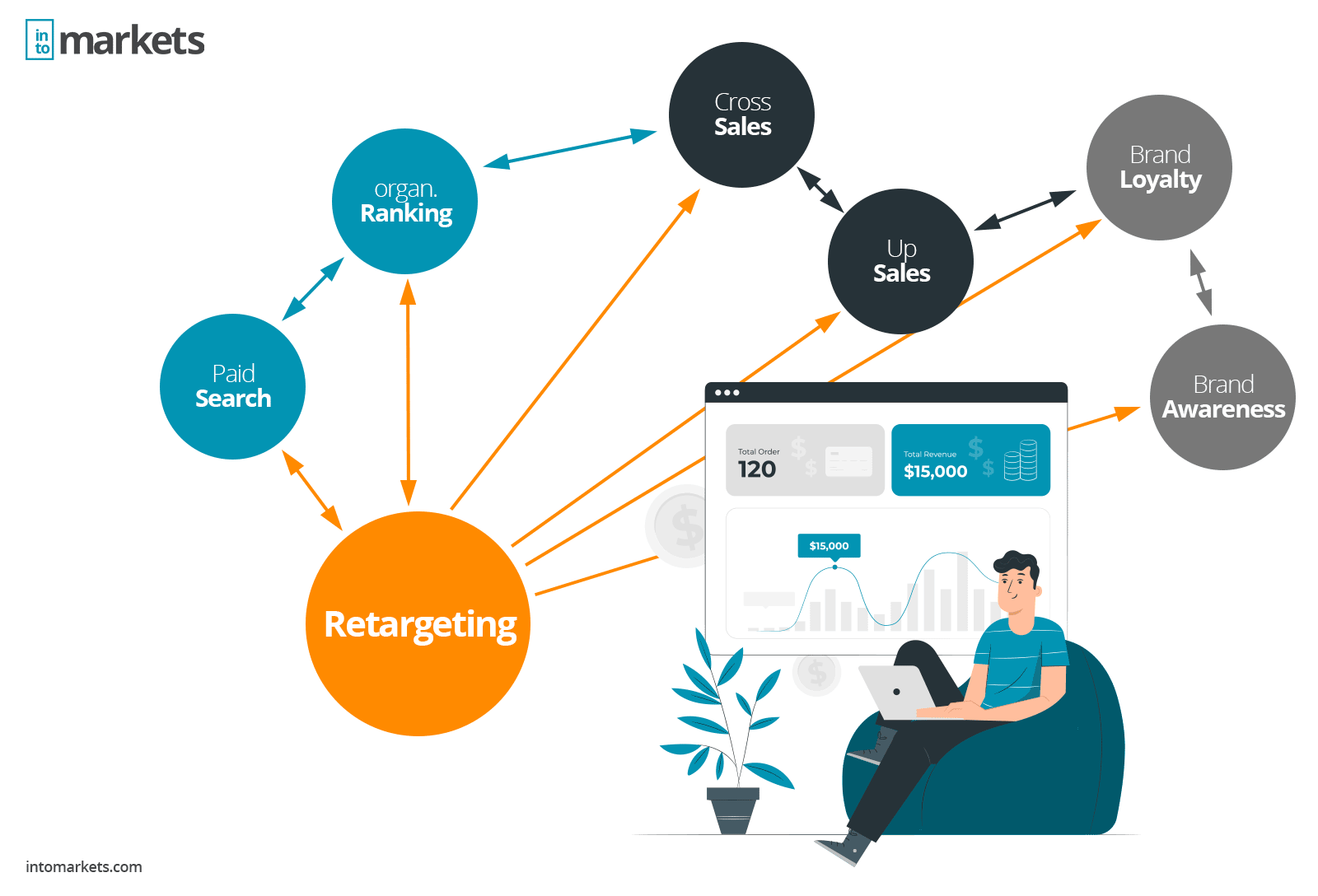
In addition, you have to see Amazon clearly different from Google. In Google, paid advertising, whether paid search or display campaigns, is detached from the organic reach of a product within the SERPs (Search Engine Result Pages). If you turn off the ads, the traffic is gone. With Amazon it’s different. Every single click and, most importantly, every purchase contributes to the product performance, which is linked to the rankings within the SERPs. Retargeting campaigns increase exactly these two KPIs: clicks and purchases. Even if the budget of the campaigns is reduced or they should be switched off completely, ideally they have at least directed traffic to the products, which in turn has a positive effect on the organic SERPs. So if one disregards every positive aspect of higher sales through retargeting, at least the influence of the campaigns on the ranking of the products remains, which in turn is sales-promoting.
In combination with the Dynamic eCommerce Ads and assuming that the product matches the purchasing behavior of the target group, Amazon retargeting campaigns are a highly effective way to increase sales. Of course, these campaigns are also subject to fluctuations due to external influences such as seasonality or competitor activity. In an average setting with well-optimized product data and professionally set up campaigns, a ROAS of 4 to 5 (corresponding to an ACoS of 20 to 25%) through Amazon Retargeting is not uncommon and is therefore often in the profitability range.
Amazon Retargeting Example With Decreasing Marginal Revenue Calculation
Advertising campaigns never work linearly in terms of the cost/income ratio, and that applies to performance marketing as much as to programmatic advertising. Even for DOOH (Digital Out Of Home) campaigns and even for printed advertisements the same basic rule applies: Above a certain threshold, no higher, even decreasing return on campaigns can be expected. In other words, above a specific value of advertising expenditure, the campaigns have reached a maximum level of profitability. This is based on the decreasing threshold value that we find in every market – there are no endless returns because at some point every market is “saturated” and at some point “oversaturated”.
Let’s take a concrete look at this in the case of an Amazon retargeting campaign and calculate the marginal return. This is decisive for the daily or monthly limit at which advertising spending starts to be profitable or when it begins to stagnate.
Amazon retargeting campaign with an ASIN
- In the first month 2,000 EUR will be invested in an Amazon retargeting campaign. The return here is 4,000 EUR, so the ROAS is 2.
- In the second month 4,000 EUR are invested. The yield rises to 12,000 EUR. The ROAS is now at 3.
- In the third month 8,000 EUR are invested. The yield rises to 32,000 EUR. The ROAS is now at 4.
- In the fourth month 12,000 EUR are invested. The yield rises to 48,000 EUR. The ROAS is still at 4.
- In the fifth month 16,000 EUR are invested. The yield rises to 56,000 EUR. The ROAS goes down to 3.5.
- In the sixth month 14,000 EUR are invested. The return goes down to 53.200. The ROAS increases slightly to 3.8.
The profitability threshold for this retargeting campaign is therefore between EUR 12 000 and EUR 14 000. If you only consider the sales generated by the campaign alone, you could certainly increase your advertising expenditure to over 16,000 EUR. However, they would not become more profitable – on the contrary. The campaigns will cost additional money, while the profitability will decrease.
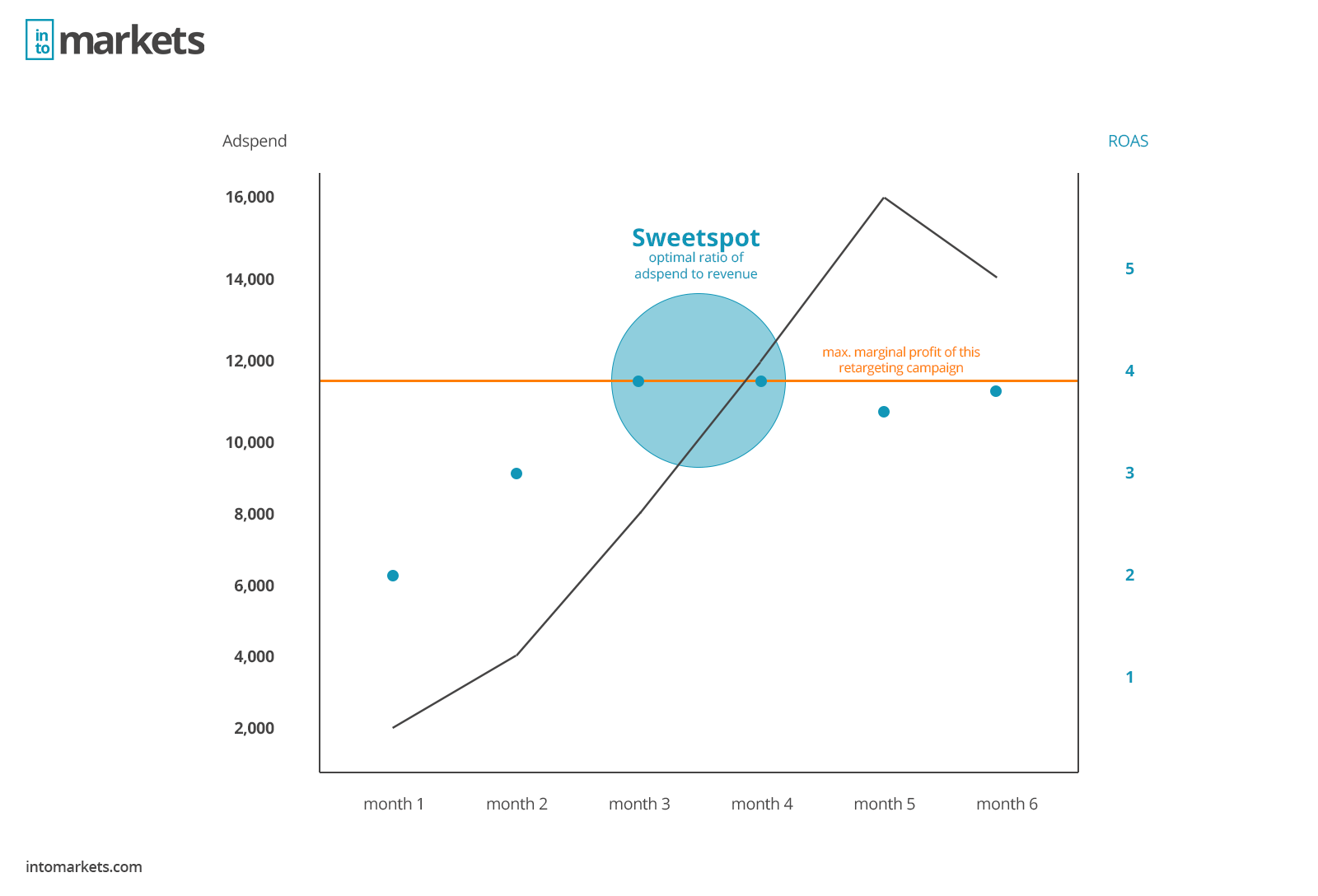
This situation can still be okay if the primary goal is to maximize sales. However, if the goal of the retargeting campaign is maximum profit, the monthly budget for this campaign must be limited between 12,000 and 14,000 EUR. This is, of course, only an artificial and very isolated calculation that ignores any seasonality, product availability, competitor activity, and other key factors. Just because the ROAS does not increase or even stagnates in a month or two does not mean that is has fallen into a decreasing marginal return. However, it is a possible indicator and should be recorded accordingly in campaign reporting.
Get the retargeting article as PDF summary
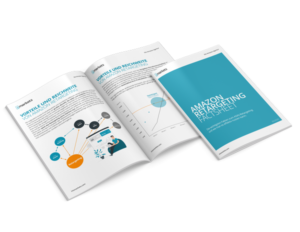 Download all important facts about ASIN retargeting with Amazon DSP directly as a compact PDF – no registration needed, and no personal data will be stored.
Download all important facts about ASIN retargeting with Amazon DSP directly as a compact PDF – no registration needed, and no personal data will be stored.
Click here to download
Tip: Always Consider Amazon as an Ecosystem
To make things a little more complex: Even a declining ROAS within the Amazon retargeting campaign can be associated with an increase in profitability. It is important to note the big difference to Google or Facebook, since here the campaigns pay for nothing but themselves. Amazon is different. Each sale and EUR generated by retargeting triggers the sales history of the advertised product (or “BSR” = Best Seller Rank) within the marketplace, and this in turn pays into the organic rankings and the performance of the PPC campaigns.
So if you increase the traffic with retargeting campaigns on your own products, it is also quite likely that an increasing number of Amazon keywords within the search result pages for this product will rank organically (better). Higher visibility goes hand in hand with more traffic and this in turn (provided the product is professionally optimized for the algorithm and target group, in short, “retail-ready”) leads to higher sales. Sales are then improved by the product’s sales history, which in turn may lead to lower ACoS values within PPC campaigns.
In other words: Every Euro invested in retargeting can have a lasting positive effect on sales in Amazon – regardless of your profitability within the retargeting campaigns
Amazon Retargeting Costs – How Expensive Are These Dsp Campaigns?
It is not possible to answer this question in a generalized way, because the goals of the advertiser or, in the case of Amazon, the goals of the seller or vendor always come first. However, one can basically assume that the Amazon DSP is a strongly data-driven approach to advertising. For the algorithms and mechanisms to work, enough data, i.e. impressions and clicks, is needed to make reliable statements about the success of the campaigns. “Sufficient data” also means that the funnel (i.e. the broadest possible targeting) should be opened wide, and this can only be done through advertising budgets.
As said before, it depends on the goal that you are pursuing Amazon Retargeting. In general, however, one can say that such campaigns should be based on a monthly budget of at least 3,000 EUR. You can also spend significantly less budget in the Amazon DSP self-service for retargeting campaigns, but then there will be less user data available to work with (or the Amazon algorithm).
Of course, there are no limits to what can be achieved. Even with 10 to 20 different ASINs, it is possible to profitably invest 20,000 to 30,000 EUR per month in retargeting campaigns within one marketplace, (e.g. only in Germany. ) This may sound like a lot at first, but you must always keep the profitability of the campaigns in mind. As long as the ROAS is stable or remains in the profitable area, the limit of the monthly advertising expenditure can and should be open in the retargeting area, similar to PPC campaigns.
Conclusion: ASIN Retargeting Is a Mandatory Program in Amazon Advertising
As explained above, ASIN Retargeting is seamlessly integrated into Amazon Advertising in the narrower sense and into the entire marketplace ecosystem as a whole. Offering only a good product is no longer enough. A professional product data optimisation is certainly a good and essential start, but in most cases it will not be enough to position a product permanently. Advertising is and will remain the biggest and decisive factor on Amazon.
With an increasing range of products and a simultaneous increase in click prices for PPC campaigns, ASIN Retargeting is a useful and necessary addition to the Amazon Advertising Mix. If you as a retailer or brand/manufacturer that has put a lot of work into product optimization and regularly invests a considerable budget in paid search, then retargeting of users willing to buy is actually a mandatory program. No matter how good the product is and how efficiently the Paid Search campaigns run on it, there will always be users who do not immediately close despite high buying interest. The more expensive or complex the product, the longer a customer journey naturally takes.
It would be fatal to hope that a prospective buyer will find his way back to the purchase after a one-time product contact. On the other hand, accompanying the potential buyer throughout his entire purchase decision process with retargeting campaigns and thus significantly increasing the conversion rate and sales is definitely the smartest strategy. If this ” user guidance” type of advertising is so profitable, then there is actually only one question left: Why not rely on Amazon Retargeting?
Request an Amazon ASIN Retargeting without commitment
Have we sparked your interest? Then send us your ASINs and we will check quickly and efficiently if and how Amazon ASIN-Retargeting can be profitable for your products. We will contact you and go through your options for future retargeting campaigns in a free initial consultation.
Tip: We can also direct traffic from your competitors’ brands to your products. Let’s just have a personal meeting to develop a strategy to determine which targeting options are most likely to be suitable for your budget. We are eager to get to know your products and your brand in order to generate more profit for you.





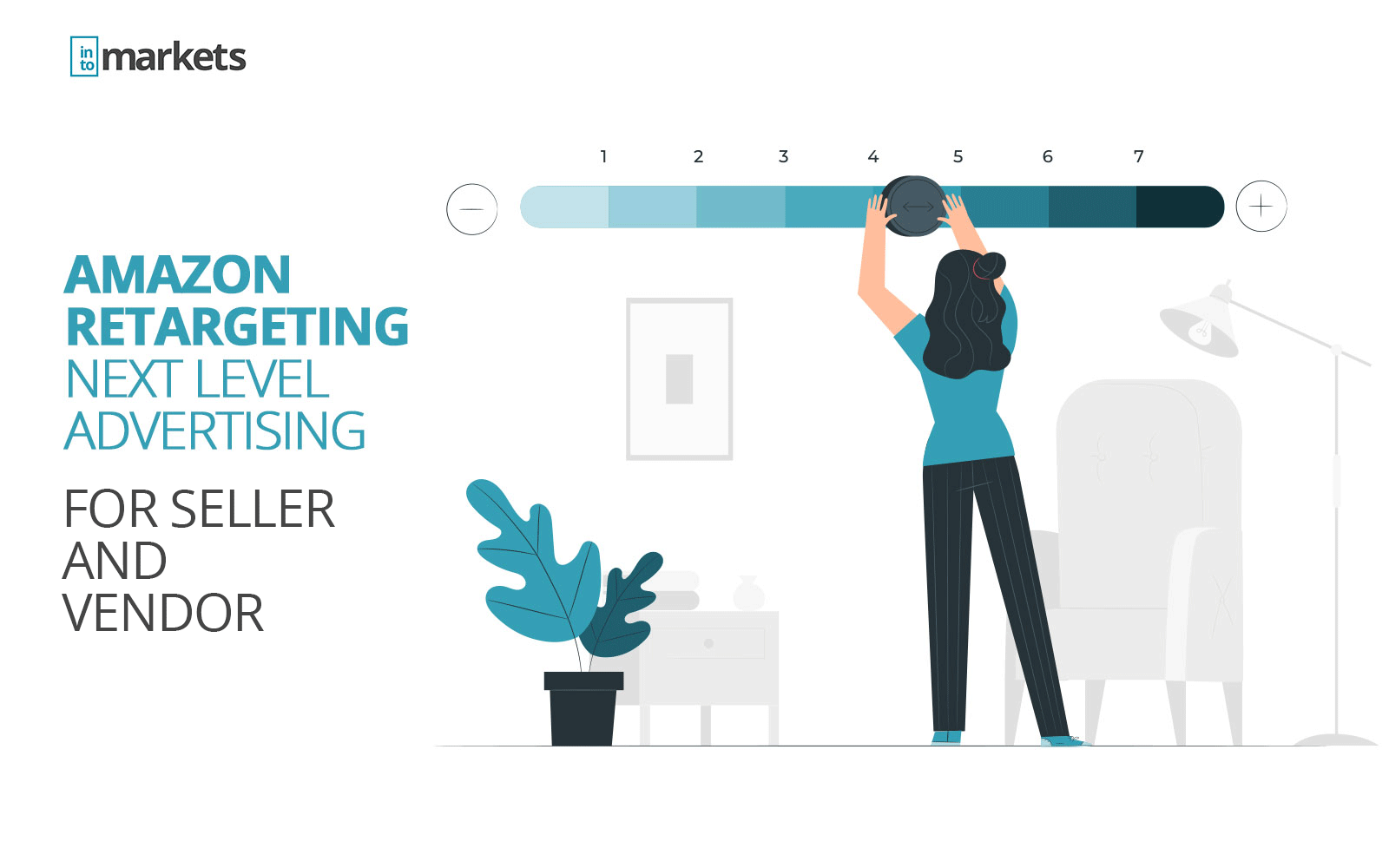

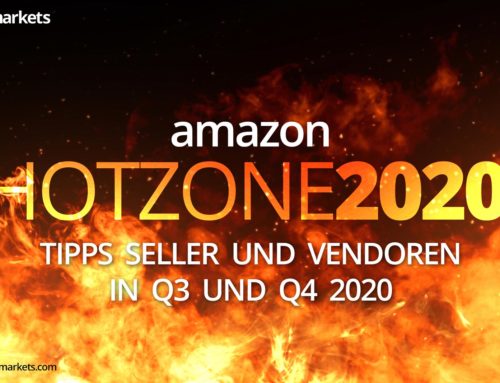
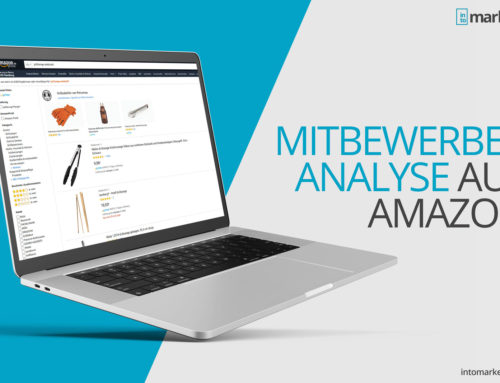
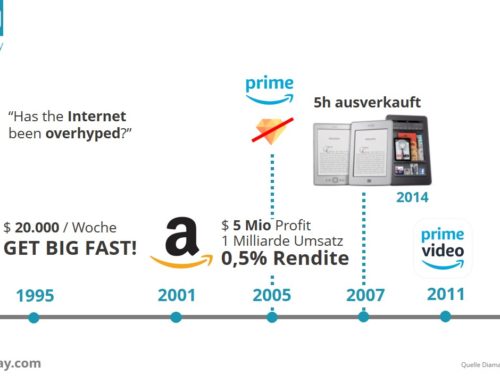


Leave A Comment